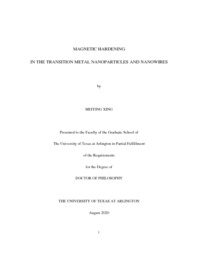
ATTENTION: The works hosted here are being migrated to a new repository that will consolidate resources, improve discoverability, and better show UTA's research impact on the global community. We will update authors as the migration progresses. Please see MavMatrix for more information.
Show simple item record
| dc.contributor.advisor | Liu, J.Ping | |
| dc.creator | Xing, Meiying | |
| dc.date.accessioned | 2022-08-24T15:15:54Z | |
| dc.date.available | 2022-08-24T15:15:54Z | |
| dc.date.created | 2020-08 | |
| dc.date.issued | 2020-08-27 | |
| dc.date.submitted | August 2020 | |
| dc.identifier.uri | http://hdl.handle.net/10106/30880 | |
| dc.description.abstract | Permanent magnets are important materials widely used in advanced technologies including electric vehicles, windmills, memory devices, magnetic levitation transportation, and biomedical apparatus. Rare-earth-based compounds with excellent magnetic performance are dominant in the permanent magnet market. However, researchers have also worked on rare-earth-free permanent magnets ascribed to the rare-earth crisis. For fundamental and application points of view, in this thesis, we investigated magnetic hardening in 3d transition metal nanostructures by controlling the morphology and composition. Nanoscale Co particles with single hcp crystalline structure were synthesized. As a result, the optimum coercivity of 2.7 kOe is obtained in the Co nanoparticles, owing to the size effect and the coherent rotation mechanism in magnetization reversal. The magnetic hardening is achieved in nickel carbide and iron carbide by introducing carbon atoms into the interstitial positions and the size control of the nanoparticles. To take advantage of magnetocrystalline anisotropy and shape anisotropy to enhance the coercivity, Co nanowires (NWs) with varied diameter and aspect ratio, and iron carbide nanorods were successfully synthesized. The record high coercivity of 13.0 kOe and energy product of 60 MGOe were achieved in the Co NWs attributed to the geometrical effect. The magnetization reversal mode is investigated by measuring the angular dependence of coercivity and comparing with the analytical results of the Stoner-Wohlfarth model.
To produce bulk nanostructured magnets for application purpose, we fabricated Co NW assemblies by compressing the nanowires together. Energy product of 20 MGOe of the assemblies has been achieved. The proximity effect on the magnetic hardening of consolidated Co NW assemblies was studied.
In addition, surface oxidized Co nanoparticles and nanowires have provided us a unique opportunity to study microstructural effects on the exchange bias in the Co/CoO core-shell nanostructures. Study of temperature dependence of the exchange bias field, the coercive field and the training effect in the Co/CoO core-shell nanostructures reveals the importance of the interplay of the different magnetic anisotropy at the interface. Moreover, the exchange bias induced by the Verwey transition is observed in Fe5C2/Fe3O4 core-shell systems. The corresponding exchange anisotropy results in a prominent enhancement of HC at low temperatures. | |
| dc.format.mimetype | application/pdf | |
| dc.language.iso | en_US | |
| dc.subject | Ferromagnetic nanoparticles | |
| dc.subject | Ferromagnetic nanowires | |
| dc.subject | Magnetic anisotropy | |
| dc.subject | Shape anisotropy | |
| dc.subject | Coercivity | |
| dc.subject | Permanent magnets | |
| dc.subject | Materials design | |
| dc.subject | | |
| dc.title | MAGNETIC HARDENING IN THE TRANSITION METAL NANOPARTICLES AND NANOWIRES | |
| dc.type | Thesis | |
| dc.contributor.committeeMember | Koymen, Ali R. | |
| dc.contributor.committeeMember | Ngai, Joseph | |
| dc.contributor.committeeMember | Weiss, Alex | |
| dc.contributor.committeeMember | Zhang, Qiming | |
| dc.degree.department | Physics | |
| dc.degree.name | Doctor of Philosophy in Physics and Applied Physics | |
| dc.date.updated | 2022-08-24T15:15:54Z | |
| thesis.degree.department | Physics | |
| thesis.degree.grantor | The University of Texas at Arlington | |
| thesis.degree.level | Doctoral | |
| thesis.degree.name | Doctor of Philosophy in Physics and Applied Physics | |
| dc.type.material | text | |
| dc.creator.orcid | 0000-0002-1738-670X | |
Files in this item
- Name:
- XING-DISSERTATION-2020.pdf
- Size:
- 7.261Mb
- Format:
- PDF
This item appears in the following Collection(s)
Show simple item record


